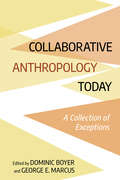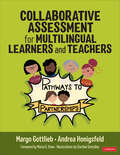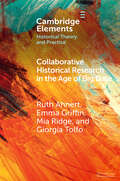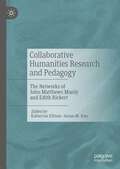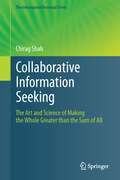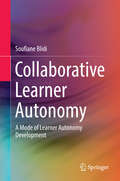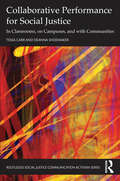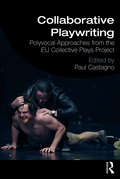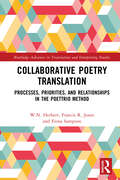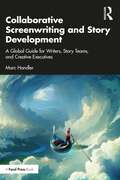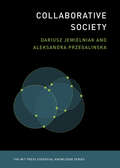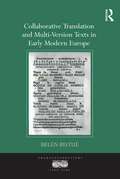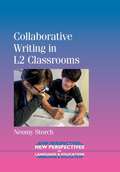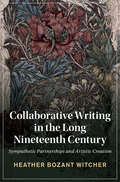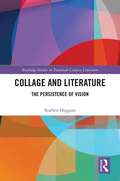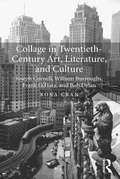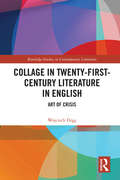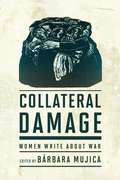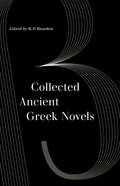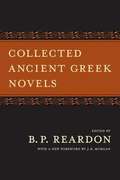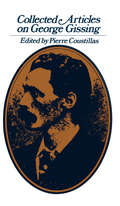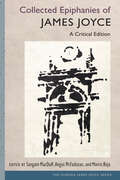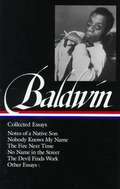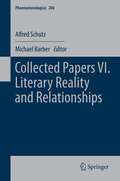- Table View
- List View
Collaborative Anthropology Today: A Collection of Exceptions
As multisited research has become mainstream in anthropology, collaboration has gained new relevance and traction as a critical infrastructure of both fieldwork and theory, enabling more ambitious research designs, forms of communication, and analysis. Collaborative Anthropology Today is the outcome of a 2017 workshop held at the Center for Ethnography, University of California, Irvine. This book is the latest in a trilogy that includes Fieldwork Is Not What It Used to Be and Theory Can Be More Than It Used to Be. Dominic Boyer and George E. Marcus assemble several notable ventures in collaborative anthropology and put them in dialogue with one another as a way of exploring the recent surge of interest in creating new kinds of ethnographic and theoretical partnerships, especially in the domains of art, media, and information. Contributors highlight projects in which collaboration has generated new possibilities of expression and conceptualizations of anthropological research, as well as prototypes that may be of use to others contemplating their own experimental collaborative ventures.
Collaborative Assessment for Multilingual Learners and Teachers: Pathways to Partnerships
by Margo Gottlieb Andrea HonigsfeldCollaborative assessment practices lead to strong partnerships Join bestselling authors Margo Gottlieb and Andrea Honigsfeld on an engaging journey to showcase collaborative assessment within assets-driven instructional practices. Integrating instructional and assessment cycles, explore how multilingual learners can interact with each other and their teachers to form lasting partnerships. Using evidence-based, research-informed strategies, Gottlieb and Honigsfeld invite educators to form partnerships to fortify linguistically and culturally sustainable assessment within their classroom routines. Throughout the learning journey, Collaborative Assessment for Multilingual Learners and Teachers offers: Practical tips and adaptable templates to reinforce assessment during instruction Vignettes that bring practical application of key concepts to life Protocols and tools for teachers and multilingual learners to engage in reflective conversations about their learning Recurring colorful icons that capture the travel theme and much more… Collaborative assessment approaches AS, FOR, and OF learning encourage relationship building to foster multilingual learners’ academic, linguistic, cultural, and social-emotional development. This practical guide supports educators in implementing collaborative assessment and welcomes multilingual learners to be partners in the process.
Collaborative Assessment for Multilingual Learners and Teachers: Pathways to Partnerships
by Margo Gottlieb Andrea HonigsfeldCollaborative assessment practices lead to strong partnerships Join bestselling authors Margo Gottlieb and Andrea Honigsfeld on an engaging journey to showcase collaborative assessment within assets-driven instructional practices. Integrating instructional and assessment cycles, explore how multilingual learners can interact with each other and their teachers to form lasting partnerships. Using evidence-based, research-informed strategies, Gottlieb and Honigsfeld invite educators to form partnerships to fortify linguistically and culturally sustainable assessment within their classroom routines. Throughout the learning journey, Collaborative Assessment for Multilingual Learners and Teachers offers: Practical tips and adaptable templates to reinforce assessment during instruction Vignettes that bring practical application of key concepts to life Protocols and tools for teachers and multilingual learners to engage in reflective conversations about their learning Recurring colorful icons that capture the travel theme and much more… Collaborative assessment approaches AS, FOR, and OF learning encourage relationship building to foster multilingual learners’ academic, linguistic, cultural, and social-emotional development. This practical guide supports educators in implementing collaborative assessment and welcomes multilingual learners to be partners in the process.
Collaborative Historical Research in the Age of Big Data: Lessons from an Interdisciplinary Project (Elements in Historical Theory and Practice)
by Ruth Ahnert Emma Griffin Mia Ridge Giorgia TolfoLiving with Machines is the largest digital humanities project ever funded in the UK. The project brought together a team of twenty-three researchers to leverage more than twenty-years' worth of digitisation projects in order to deepen our understanding of the impact of mechanisation on nineteenth-century Britain. In contrast to many previous digital humanities projects which have sought to create resources, the project was concerned to work with what was already there, which whilst straightforward in theory is complex in practice. This Element describes the efforts to do so. It outlines the challenges of establishing and managing a truly multidisciplinary digital humanities project in the complex landscape of cultural data in the UK and share what other projects seeking to undertake digital history projects can learn from the experience. This title is also available as Open Access on Cambridge Core.
Collaborative Humanities Research and Pedagogy: The Networks of John Matthews Manly and Edith Rickert
by Katherine Ellison Susan M. KimThis edited collection of essays brings together scholars across disciplines who consider the collaborative work of John Matthews Manly and Edith Rickert, philologists, medievalists and early modernists, cryptologists, and education reformers. These pioneers crafted interdisciplinary partnerships as they modeled and advocated for cooperative alliances at every level of their work and in all their academic relationships. Their extensive network of intellectual partnerships made possible groundbreaking projects, from the eight-volume Text of the Canterbury Tales (1940) to the deciphering of the Waberski Cipher, yet, except for their Chaucer work, their many other accomplishments have received little attention. Collaborative Humanities Research and Pedagogy not only surveys the rich range of their work but also emphasizes the transformative intellectual and pedagogical benefits of collaboration.
Collaborative Information Seeking: The Art and Science of Making the Whole Greater than the Sum of All (The Information Retrieval Series #34)
by Chirag ShahToday's complex, information-intensive problems often require people to work together. Mostly these tasks go far beyond simply searching together; they include information lookup, sharing, synthesis, and decision-making. In addition, they all have an end-goal that is mutually beneficial to all parties involved. Such "collaborative information seeking" (CIS) projects typically last several sessions and the participants all share an intention to contribute and benefit. Not surprisingly, these processes are highly interactive. Shah focuses on two individually well-understood notions: collaboration and information seeking, with the goal of bringing them together to show how it is a natural tendency for humans to work together on complex tasks. The first part of his book introduces the general notions of collaboration and information seeking, as well as related concepts, terminology, and frameworks; and thus provides the reader with a comprehensive treatment of the concepts underlying CIS. The second part of the book details CIS as a standalone domain. A series of frameworks, theories, and models are introduced to provide a conceptual basis for CIS. The final part describes several systems and applications of CIS, along with their broader implications on other fields such as computer-supported cooperative work (CSCW) and human-computer interaction (HCI). With this first comprehensive overview of an exciting new research field, Shah delivers to graduate students and researchers in academia and industry an encompassing description of the technologies involved, state-of-the-art results, and open challenges as well as research opportunities.
Collaborative Learner Autonomy: A Mode of Learner Autonomy Development
by Soufiane BlidiThe book investigates the Reading Circles (RCs) learning opportunity as a mode of autonomous learning in the Middle East tertiary education context. This investigation presents learners' positive perceptions of learner autonomy and their readiness to adopt related practices. Building on findings from these RCs, the book introduces collaborative learner autonomy (CLA) as a novel interpretation of learner autonomy for use in educational contexts in the Middle East. The CLA put forward in the book emphasizes the constructive role of teachers and educational establishments with other stakeholders in developing autonomy in their learners. As a theory of gradual development of learner autonomy, CLA represents a new dynamic learner autonomy development process consisting of individual, competitive, collaborative, and autonomous stages. The book also suggests that it is a shared responsibility that students, teachers, educational establishments, families, society and the educational systems should assume in a spirit of partnership.
Collaborative Performance for Social Justice: In Classrooms, on Campuses, and with Communities (Routledge Social Justice Communication Activism Series)
by Tessa Carr Deanna ShoemakerThis engaging book offers a broad spectrum of collaborative and accessible performance-based practices that promote social justice within college classrooms, rehearsal spaces, campus stages and local communities.Performance is an inherently collective and embodied endeavor. As a form of communication activism, performance also serves as a powerful mode of teaching and learning that demands equitable relationships and mutually established group norms that offer all a seat at the table. Informed by intersectional feminist and antiracist theories, the authors present collaborative performance case studies, ranging from interventions into local histories of oppression to creative protests of campus and cultural practices, to staged interruptions of social discourses and representational systems that perpetuate structural inequities. Illustrating the multiple possibilities of performance, the book offers adaptable tools, evocative stories, and vivid examples from diverse bodies of work. This engaged scholarship is committed to honoring multiple forms of knowledge, acknowledging and building the capacities of individuals and organizations, identifying and developing more spaces for critical dialogue, and envisioning and performing a more socially just world.This book is essential reading for scholars and practitioners of communication, theater, performance studies, arts-based education, and social justice activism.
Collaborative Playwriting: Polyvocal Approaches from the EU Collective Plays Project
by Paul CastagnoIn Collaborative Playwriting, five collectively written plays apply polyvocal methods in which clash and frisson replace synthesis, a dialogic approach to collective writing that has never before been articulated or documented. Based on the EU Collective Plays Project, this collection of plays showcases each voice in dialogic tension and in relation to the other voices of the text, offering an entirely novel approach to new play development that challenges the single (and privileged) authorial voice. Castagno’s case-study approach provides detailed commentary on each of the various experimental methods, exploring the plays’ processes in detail. The book offers an evolutionary path forward in how to develop new work, thus encouraging and promoting the writing of collective, hybrid plays as having profound benefits for all playwrights. The ground breaking approaches to playmaking in Collaborative Playwriting will appeal to playwriting programs, instructors, academics, professional playwrights, theaters and new play development programs; as well as courses in gender LGBTQ studies, script analysis, dramaturgy and dramatic literature across the theater studies curricula.
Collaborative Poetry Translation: Processes, Priorities, and Relationships in the Poettrio Method (ISSN)
by Fiona Sampson W.N. Herbert Francis R. JonesThis volume provides an account of collaborative poetry translation in practice. The book focuses on the 'poettrio' method as a case study. This process brings together the source-language poet, the target-language poet, and a language advisor serving as a bilingual mediator between the two.Drawing on data from over 100 hours of recorded footage and interviews, Collaborative Poetry Translation offers both qualitative and quantitative analyses of the method in practice, exploring such issues as poem selection, translation strategies, interaction between participants, and the balancing act between the different cultures at play. A final chapter highlights both the practical and research implications for practices of collaborative translation. This innovative work is situated in an interdisciplinary framework of collaborative translation, poetry translation, poetry and creative writing, and it addresses concerns ranging from the ethnography of collaboration to contemporary publishing practice.It will be of interest to students, scholars, and specialists in translation studies, comparative literature, literary studies, and creative writing, as well as creative practitioners.
Collaborative Screenwriting and Story Development: A Global Guide for Writers, Story Teams, and Creative Executives
by Marc HandlerThis is a comprehensive guide to teach writing and story development from a collaborative global perspective. This book teaches writers how to take full advantage of emerging opportunities, both locally and globally. With an increasing number of international co-productions and many screenwriters now working collaboratively in writers rooms and development groups, author Marc Handler explains how to work cooperatively with others to break stories, plan seasons, create characters, and build series. To succeed, readers will learn how to give and receive feedback effectively, adapt to the style and constraints of executives and brands, and contribute to the team building process, all within an increasingly global media industry that is in constant flux. This book will help readers develop a global perspective, ensuring that they are prepared for new opportunities as they arise. Marc Handler provides cultural insight and understanding as he describes the fundamentals as well as advanced story skills. This book is essential reading for students taking classes such as Screenwriting Fundamentals, Writing for Film and TV, Introduction to Television Writing, and Advanced Screenwriting, as well as aspiring and early career screenwriters, showrunners, producers, and creative executives.
Collaborative Society (The MIT Press Essential Knowledge Series)
by Dariusz Jemielniak Aleksandra PrzegalinskaHow networked technology enables the emergence of a new collaborative society. Humans are hard-wired for collaboration, and new technologies of communication act as a super-amplifier of our natural collaborative mindset. This volume in the MIT Press Essential Knowledge series examines the emergence of a new kind of social collaboration enabled by networked technologies. This new collaborative society might be characterized as a series of services and startups that enable peer-to-peer exchanges and interactions though technology. Some believe that the economic aspects of the new collaboration have the potential to make society more equitable; others see collaborative communities based on sharing as a cover for social injustice and user exploitation.The book covers the “sharing economy,” and the hijacking of the term by corporations; different models of peer production, and motivations to participate; collaborative media production and consumption, the definitions of “amateur” and “professional,” and the power of memes; hactivism and social movements, including Anonymous and anti-ACTA protest; collaborative knowledge creation, including citizen science; collaborative self-tracking; and internet-mediated social relations, as seen in the use of Instagram, Snapchat, and Tinder. Finally, the book considers the future of these collaborative tendencies and the disruptions caused by fake news, bots, and other challenges.
Collaborative Translation and Multi-Version Texts in Early Modern Europe (Transculturalisms, 1400-1700)
by Belén BistuéFocusing on team translation and the production of multilingual editions, and on the difficulties these techniques created for Renaissance translation theory, this book offers a study of textual practices that were widespread in medieval and Renaissance Europe but have been excluded from translation and literary history. The author shows how collaborative and multilingual translation practices challenge the theoretical reflections of translators, who persistently call for a translation text that offers a single, univocal version and maintains unity of style. In order to explore this tension, Bistué discusses multi-version texts, in both manuscript and print, from a diverse variety of genres: the Scriptures, astrological and astronomical treatises, herbals, goliardic poems, pamphlets, the Greek and Roman classics, humanist grammars, geography treatises, pedagogical dialogs, proverb collections, and romances. Her analyses pay careful attention to both European vernaculars and classical languages, including Arabic, which played a central role in the intense translation activity carried out in medieval Spain. Comparing actual translation texts and strategies with the forceful theoretical demands for unity that characterize the reflections of early modern translators, the author challenges some of the assumptions frequently made in translation and literary analysis. The book contributes to the understanding of early modern discourses and writing practices, including the emerging theoretical discourse on translation and the writing of narrative fiction--both of which, as Bistué shows, define themselves against the models of collaborative translation and multi-version texts.
Collaborative Writing in L2 Classrooms
by Neomy StorchIn this first book-length treatment of collaborative writing in second language (L2) classrooms, Neomy Storch provides a theoretical, pedagogical and empirical rationale for the use of collaborative writing activities in L2 classes, as well as some guidelines about how to best implement such activities in both face-to-face and online mode. The book discusses factors that may impact on the nature and outcomes of collaborative writing, and examines the beliefs about language learning that underpin learners' and teachers' attitudes towards pair and group work. The book critically reviews the available body of research on collaborative writing and identifies future research directions, thereby encouraging researchers to continue investigating collaborative writing activities.
Collaborative Writing in the Long Nineteenth Century: Sympathetic Partnerships and Artistic Creation (Cambridge Studies in Nineteenth-Century Literature and Culture #135)
by Heather Bozant WitcherBringing the collaborative process to life through an array of examples, Heather Witcher shows that sympathetic co-creation is far more than the mere act of writing together. While foregrounding the material aspects of collaboration – hands uniting on the page, blank space left for fellow contributors, the writing and exchanging of drafts – this study also illuminates its social aspects and its reliance on Victorian liberalism: dialogue, the circulation of correspondence, the lived experience of collaboration, and, on a less material plane, transhistorical collaborations with figures of the past. Witcher takes a broad approach to these partnerships and, in doing so, challenges traditional expectations surrounding the nature of authorship itself, not least its typical classification as a solitary activity. Within this new framework, collaboration enables the titles of 'coauthor,' 'influencer,' 'editor,' 'critic,' and 'inspiration' to coexist. This book celebrates the plurality of collaboration and underscores the truly social nature of nineteenth-century writing.
Collage and Literature: The Persistence of Vision (Routledge Studies in Twentieth-Century Literature)
by Scarlett HigginsCollage and Literature analyzes how and why the history of literature and art changed irrevocably beginning in the early years of the twentieth century, and what that change has meant for late modernism and postmodernism. Starting from Pablo Picasso’s 1912 gesture, breaking the fundamental logic of representation, of pasting a piece of oilcloth onto a canvas, and moving up to Kenneth Goldsmith’s 2015 reading of an autopsy report of an unarmed young black man shot by police (which he framed as a poem entitled Michael Brown’s Body) this volume moves through a series of case studies encapsulating issues of juxtaposition and framing, the central ways identify collage. Its thesis is that collage—and, in fact, only collage—meaningfully overcomes formal and generic boundaries between the literary and the non-literary. The overwriting of these traditional boundaries happens in the service of collage’s anti-narrative drive, a drive that may be, in turn, interruptive or destructive. The expansion of collage’s horizons— broadly, to include the use of radical juxtaposition in the arts—reveals a surprisingly wide range of American artists and writers using the logic of juxtaposition as they imagine new worlds, disrupt accepted narratives about society and art, and create meaning through form as much as through paraphrasable content. In addressing a wide range of contested issues, recent artists realize the shocking force of collage. By recovering this shock, Collage and Literature restores collage to its multimedia origins in order to reveal its powerful and political affects.
Collage in Twentieth-Century Art, Literature, and Culture: Joseph Cornell, William Burroughs, Frank O’Hara, and Bob Dylan
by Rona CranEmphasizing the diversity of twentieth-century collage practices, Rona Cran's book explores the role that it played in the work of Joseph Cornell, William Burroughs, Frank O'Hara, and Bob Dylan. For all four, collage was an important creative catalyst, employed cathartically, aggressively, and experimentally. Collage's catalytic effect, Cran argues, enabled each to overcome a potentially destabilizing crisis in representation. Cornell, convinced that he was an artist and yet hampered by his inability to draw or paint, used collage to gain access to the art world and to show what he was capable of given the right medium. Burroughs' formal problems with linear composition were turned to his advantage by collage, which enabled him to move beyond narrative and chronological requirement. O'Hara used collage to navigate an effective path between plastic art and literature, and to choose the facets of each which best suited his compositional style. Bob Dylan's self-conscious application of collage techniques elevated his brand of rock-and-roll to a level of heightened aestheticism. Throughout her book, Cran shows that to delineate collage stringently as one thing or another is to severely limit our understanding of the work of the artists and writers who came to use it in non-traditional ways.
Collage in Twenty-First-Century Literature in English: Art of Crisis (Routledge Studies in Contemporary Literature)
by Wojciech DragCollage in Twenty-First-Century Literature in English: Art of Crisis considers the phenomenon of the continued relevance of collage, a form established over a hundred years ago, to contemporary literature. It argues that collage is a perfect artistic vehicle to represent the crisis-ridden reality of the twenty-first-century. Being a mixture of fragmentary incompatible voices, collage embodies the chaos of the media-dominated world. Examining the artistic, sociopolitical and personal crises addressed in contemporary collage literature, the book argues that the 21st Century has brought a revival of collage-like novels and essays.
Collateral Damage: Women Write about War
by Aminatta Forna Domnica Radulescu V. V. Ganeshananthan Christine Evans Scholastique Mukasonga Marjorie Agosín Nancy Sherman Miyoko Hikiji Carolin Emcke Michèle Sarde Bárbara Mujica Peipei Qiu Ghusoon Mekhaber Al-Taiee Florinda Ruiz Carolina Rivera Escamilla Trudy Mercadal Carmen Duarte Betty MilanFrom Homer to Tim O’Brien, war literature remains largely the domain of male writers, and traditional narratives imply that the burdens of war are carried by men. But women and children disproportionately suffer the consequences of conflict: famine, disease, sexual abuse, and emotional trauma caused by loss of loved ones, property, and means of subsistence.Collateral Damage tells the stories of those who struggle on the margins of armed conflict or who attempt to rebuild their lives after a war. Bringing together the writings of female authors from across the world, this collection animates the wartime experiences of women as military mothers, combatants, supporters, war resisters, and victims. Their stories stretch from Rwanda to El Salvador, Romania to Sri Lanka, Chile to Iraq. Spanning fiction, poetry, drama, essay, memoir, and reportage, the selections are contextualized by brief author commentaries.The first collection to embrace so wide a range of contemporary authors from such diverse backgrounds, Collateral Damage seeks to validate and shine a light on the experiences of women by revealing the consequences of war endured by millions whose voices are rarely heard.
Collected Ancient Greek Novels
by B. P. ReardonProse fiction, although not always associated with classical antiquity, flourished in the early Roman Empire, not only in realistic Latin novels but also and indeed principally in the Greek ideal romance of love and adventure. Enormously popular in the Renaissance, these stories have been less familiar in later centuries. Translations of the Greek stories were not readily available in English before B.P. Reardon’s first appeared in 1989.Nine complete stories are included here as well as ten others, encompassing the whole range of classical themes: romance, travel, adventure, historical fiction, and comic parody. A foreword by J.R. Morgan examines the enormous impact this groundbreaking collection has had on our understanding of classical thought and our concept of the novel.
Collected Ancient Greek Novels
by B. P. Reardon J. R. Morgan<p>Prose fiction, although not always associated with classical antiquity, did in fact flourish in the early Roman Empire, not only in realistic Latin novels but also and indeed principally in the Greek ideal romance of love and adventure to which they are related. Popular in the Renaissance, these stories have been less familiar in later centuries. Translations of the Greek stories were not readily available in English before B.P. Reardon’s excellent volume. <p>Nine complete stories are included here as well as ten others, encompassing the whole range of classical themes: ideal romance, travel adventure, historical fiction, and comic parody. A new foreword by J.R. Morgan examines the enormous impact this groundbreaking collection has had on our understanding of classical thought and our concept of the novel. </p>
Collected Articles on George Gissing
by Pierre CoustillasFirst Published in 1968. Routledge is an imprint of Taylor & Francis, an informa company.
Collected Epiphanies of James Joyce: A Critical Edition (The Florida James Joyce Series)
by James JoyceJoyce’s early texts, which informed his later masterpieces, available for the first time in a comprehensive critical edition This book offers the first critical edition of the forty short texts James Joyce called “epiphanies.” Among Joyce’s earliest literary compositions, although published posthumously, the epiphanies are a series of highly polished miniatures, many of which Joyce reused in his later writings. By presenting the epiphanies with background details and thorough annotations, this edition provides a vivid insight into his art. Collected Epiphanies of James Joyce features an introduction to the texts that summarizes Joyce’s concept of epiphany; their biographical and cultural context; their echoes and adaptations in Stephen Hero, Dubliners, A Portrait of the Artist as a Young Man, Ulysses, and Finnegans Wake; and their critical reception and editorial history. Each epiphany is transcribed directly from its original manuscript, accompanied by extensive notes that include more information specific to each piece, as well as textual variants. Styled as prose poems, dramatic sketches, or combinations of the two, the epiphanies can be seen not only as lyrical counterparts to Joyce’s poetry in Chamber Music but also as bridges to the writer’s landmark fiction. This collection demonstrates that the epiphanies offer a paradigm case for studying the development of Joyce’s work as a whole, prompting a reassessment of their literary significance. A volume in the Florida James Joyce Series, edited by Sam Slote
Collected Essays
by James BaldwinNovelist, essayist, and public intellectual, James Baldwin was one of the most brilliant and provocative literary figures of the postwar era, and one of the greatest African-American writers of this century. A self-described "transatlantic commuter" who spent much of his life in France, Baldwin joined cosmopolitan sophistication with a fierce engagement in social issues. Edited by Nobel laureate Toni Morrison, the Library of America's Collected Essays-the most comprehensive gathering of Baldwin's nonfiction ever published-confirms him as a uniquely prophetic voice in American letters. With burning passion and jabbing, epigrammatic wit, Baldwin fearlessly articulated issues of race and democracy and American identity in such famous essays as "The Harlem Ghetto," "Everybody's Protest Novel," "Many Thousands Gone," and "Stranger in the Village. " Here are the complete texts of his early landmark collections, Notes of a Native Son (1955) and Nobody Knows My Name (1961), which established him as an essential intellectual voice of his time, fusing in unique fashion the personal, the literary, and the political. "One writes," he stated, "out of one thing only-one's own experience. Everything depends on how relentlessly one forces from this experience the last drop, sweet or bitter, it can possibly give. " With singular eloquence and unblinking sharpness of observation he lived up to his credo: "I want to be an honest man and a good writer. " The classic The Fire Next Time (1963), perhaps the most influential of his writings, is his most penetrating analysis of America's racial divide and an impassioned call to "end the racial nightmare. . . and change the history of the world. " The later volumes No Name in the Street (1972) and The Devil Finds Work (1976) chart his continuing response to the social and political turbulence of his era and include his remarkable works of film criticism. A further 36 essays-nine of them previously uncollected-include some of Baldwin's earliest published writings, as well as revealing later insights into the language of Shakespeare, the poetry of Langston Hughes, and the music of Earl Hines.
Collected Papers VI. Literary Reality and Relationships (Phaenomenologica #206)
by Alfred Schutz Michael BarberThis book contains texts devoted by Alfred Schutz to the "normative" areas of literature and ethics. It includes writings dealing with the author-reader relationship, multiple realities, the literary province of meaning, and Schutz's views on equality. Never published in English commentaries on Goethe's novel and the account of personality in the social world appear in this volume.
